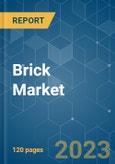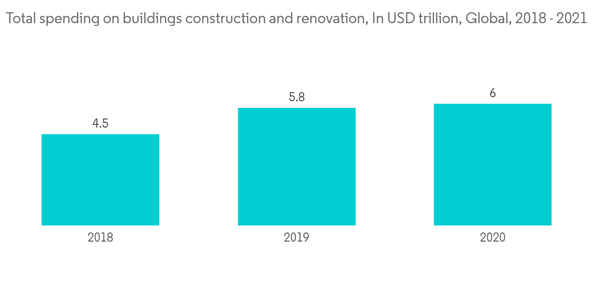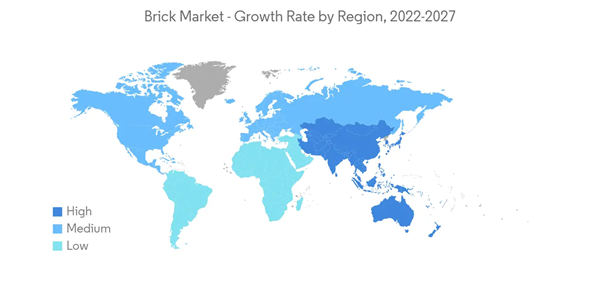COVID-19 negatively impacted the market in 2020 and 2021. All the construction work and other activities were put on hold to curb the spreading of the virus, thereby negatively affecting the market. However, the market is projected to grow steadily in the coming years, owing to increased building and construction activities.
Key Highlights
- Over the short term, the primary factor driving the brick market's growth is the building segment's high demand.
- On the flip side, increasing trends of prefabricated construction components are expected to restrain the market's growth.
- Furthermore, the development of new materials for bricks and increasing trends of customized bricks are likely to act as an opportunity for the market over the forecast period.
- Asia-Pacific is expected to remain the largest market due to the region's large-scale production and consumption of brick products.
Brick Market Trends
Growing Demand from the Building Segment
- The global brick market is driven by rising urbanization, growing demand for residential and non-residential buildings, and construction activities to improve and develop the existing infrastructure.
- Brick is among the primary building materials used to construct all residential, commercial, and industrial buildings. Hence, growth trends in the construction industry and renovation of facilities worldwide favor the demand for bricks.
- The IEA estimates that the global building construction sector will be valued at more than USD 6.3 trillion in 2021, registering an increase of around 5% compared to 2020.
- Furthermore, According to the Institution of Civil Engineers, China, India, and the United States are expected to account for almost 60 percent of all global growth in the sector by 2025.
- As per U.S. International Trade Administration, China is the world’s largest construction market and is forecasted to grow at an annual average of 8.6% between 2022 and 2030.
- The United States was among the top construction markets globally, and per the United States Census Bureau, in 2021, the construction put in place in 2021 in the United States was valued at USD 1.589 trillion, accounting for around 4.3% of the total GDP of the country.
- In European Region, as per the European Commission, By 2030, Europe’s Renovation Wave aims at least to double the annual energy renovation rate of buildings and focus on a goal of renovating more than 35 million buildings, i.e., 13% of the total establishments in the region.
- Thus, the factors above are expected to drive the building segment of the brick market during the forecast period.
Asia-Pacific to Dominate Brick Market Studied
- Globally, Asia-Pacific holds a prominent share of the brick market, and it is expected to dominate the market studied, during the forecast period.
- Asia-pacific has seen rapid urbanization in the last few years, as developing countries, like China, India, Japan, and Indonesia, from the region are becoming a global hub for the construction industry across the world.
- Asia-Pacific dominates the construction industry, of which buildings are the major segments across the world, contributing about 46% of the global spending in the construction sector.
- China is in the midst of a construction mega-boom. The country has the largest building market in the world, making up 20% of all construction investments globally. The country alone is expected to spend nearly USD 13 trillion on buildings by 2030.
- As per Invest India and IBEF, the construction Industry in India is expected to become the 3rd largest construction market globally and to reach USD 1.4 trillion by 2025. Moreover, Real Estate Industry in India is expected to reach USD 1 trillion by 2030 and will contrib to around of% to India’s GDP.
- According to the Ministry of Finance of Japan, the construction industry in Japan generated sales of approximately JPY 136.7 trillion (~USD 1.22 trillion) in the fiscal year 2021 registering an increase of 2.1 % as compared to the FY 2020.
- In Indonesia, as per Statistics Indonesia (BPS) in the year 2021, the GDP of the construction sector in Indonesia was IDR 1,771.73 trillion (~USD 0.177 trillion). Furthermore, as per the World cement, the Indonesian construction market is expected to record a growth of 7.2% in real terms in 2022.
- Thus, the growing trends in the construction industries in the different countries of the Asia-Pacific region are expected to drive the market studied in the region, during the forecast period.
Brick Market Competitor Analysis
The brick market is fragmented. Some of the players in the market include (not in any particular order) Acme Brick Company, Brickworks, Triangle Brick Co., Brampton Brick, and GENERAL SHALE, INC.Additional benefits of purchasing the report:
- The market estimate (ME) sheet in Excel format
- 3 months of analyst support
This product will be delivered within 2 business days.
Table of Contents
1 INTRODUCTION1.1 Study Assumptions
1.2 Scope of the Study
2 RESEARCH METHODOLOGY
3 EXECUTIVE SUMMARY
4 MARKET DYNAMICS
4.1 Drivers
4.1.1 Growing Demand from the Building Segment
4.1.2 Other Drivers
4.2 Restraints
4.2.1 Increasing Trends of Prefabricated Construction Components
4.2.2 Other Restraints
4.3 Industry Value Chain Analysis
4.4 Porter's Five Forces Analysis
4.4.1 Threat of New Entrants
4.4.2 Bargaining Power of Buyers
4.4.3 Bargaining Power of Suppliers
4.4.4 Threat of Substitute Products and Services
4.4.5 Degree of Competition
5 MARKET SEGMENTATION (Market Size by Value)
5.1 Brick Type
5.1.1 Clay
5.1.2 Sand Lime
5.1.3 Fly-ash Clay
5.1.4 Other Brick Types
5.2 Application
5.2.1 Buildings
5.2.2 Path
5.2.3 Parterre
5.2.4 Other Applications
5.3 Geography
5.3.1 Asia-Pacific
5.3.1.1 China
5.3.1.2 India
5.3.1.3 Japan
5.3.1.4 South Korea
5.3.1.5 Rest of Asia-Pacific
5.3.2 North America
5.3.2.1 United States
5.3.2.2 Canada
5.3.2.3 Mexico
5.3.3 Europe
5.3.3.1 Germany
5.3.3.2 United Kingdom
5.3.3.3 France
5.3.3.4 Italy
5.3.3.5 Rest of Europe
5.3.4 South America
5.3.4.1 Brazil
5.3.4.2 Argentina
5.3.4.3 Rest of South America
5.3.5 Middle-East and Africa
5.3.5.1 Saudi Arabia
5.3.5.2 South Africa
5.3.5.3 Rest of Middle-East and Africa
6 COMPETITIVE LANDSCAPE
6.1 Mergers and Acquisitions, Joint Ventures, Collaborations, and Agreements
6.2 Market Share (%)**/Ranking Analysis
6.3 Strategies Adopted by Leading Players
6.4 Company Profiles
6.4.1 Acme Brick Company
6.4.2 Bigbloc Construction Ltd.
6.4.3 Bowerston Shale
6.4.4 Brampton Brick
6.4.5 Brickworks
6.4.6 Columbus Brick
6.4.7 GENERAL SHALE, INC.
6.4.8 Jindal Mechno Bricks
6.4.9 Lignacite Ltd
6.4.10 Oldcastle APG
6.4.11 Palmetto Brick Company
6.4.12 Supreme Concrete
6.4.13 Triangle Brick Co.
6.4.14 Xella International
7 MARKET OPPORTUNITIES AND FUTURE TRENDS
7.1 Development of New Materials for Bricks
7.2 Increasing Trends of Customized Bricks
Companies Mentioned (Partial List)
A selection of companies mentioned in this report includes, but is not limited to:
- Acme Brick Company
- Bigbloc Construction Ltd.
- Bowerston Shale
- Brampton Brick
- Brickworks
- Columbus Brick
- GENERAL SHALE, INC.
- Jindal Mechno Bricks
- Lignacite Ltd
- Oldcastle APG
- Palmetto Brick Company
- Supreme Concrete
- Triangle Brick Co.
- Xella International










